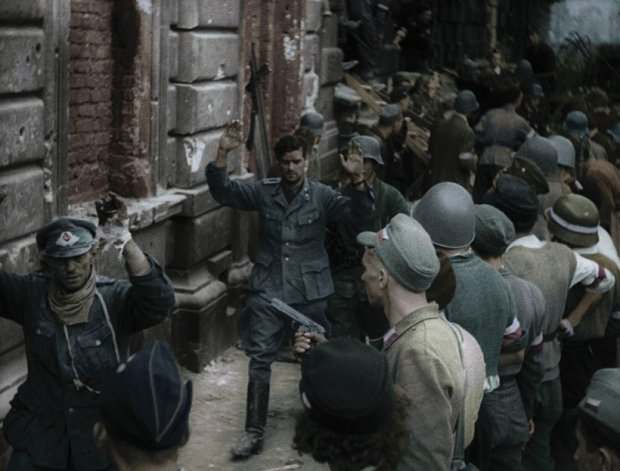The original version of the film, which was directed by Jan Komasa, is the story of two brothers, cinematographers from the Bureau of Information and Propaganda, who are commissioned to document the course of events of the Uprising. As the film description explains, they want to show the “real” war and will do anything to accompany one of the divisions. That’s not an easy task, however, as they’re chased away by the soldiers – the army had hardly any tolerance for journalists. The brothers first portray life away from the front: baking bread, kitchen work, gun manufacture. Gradually, they enter deeper and deeper – metaphorically and literally – into the heart of the Uprising.
 Still from Warsaw Uprising, courtesy of the Warsaw Uprising Museum / Next Film
Still from Warsaw Uprising, courtesy of the Warsaw Uprising Museum / Next FilmA few months after the Polish premiere, the Warsaw Uprising team began working on the English version of the film, which, they figured, needed to consist in more than just translating the script. They decided to modify the narrative, by adding another character to the plot – an American pilot and journalist, who is guided by the Polish journalists around the events in Warsaw.
We decided to base this character on a real person: the BIP had a British soldier working for them – his task was to write reportages and reports about the events in Warsaw and pass them on to London via the Błyskawica (Lightning) radio station. The Polish army believed that such information would be more comprehensible abroad if broadcast by a foreigner. In our film, we turned Cpt. Howard into an American. – Jan Ołdakowski, the director of the Warsaw Uprising Museum, explained.
The film was produced by the Warsaw Uprising Museum. The screenplay was written by Jan Ołdakowski, Piotr Śliwowski (head of the history department of the Warsaw Uprising Museum), and directed by Jan Komasa, who is also responsible for Warsaw 44, a feature film about the younger participants of the Uprising. Warsaw Uprising’s editors are Milenia Fiedler and Joanna Bruhl, while the music was composed by Bartosz Chajdecki.
We made this film because we wanted to tell the story of the Uprising to the international audience, as we are aware that it is often confused with the Ghetto Uprising. […] We want people to remember that there were two Uprisings in Warsaw – Ołdakowski stresses.